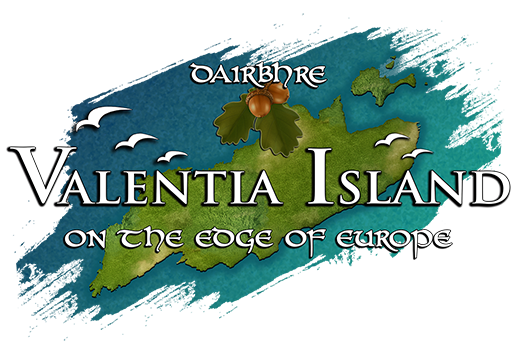Access Welcome Guide
1. Accessibility Contact & Support
If you have questions, specific requirements, or need assistance, please reach out:
- Accessibility Coordinator / Team: Sára Cselényi
- Email: [email protected]
- Phone: +353892515708
- Response target: within 3–5 working days
2. Travel & Arrival Guidance
By road (bridge)
You can reach Valentia via the Maurice O’Neill Memorial Bridge from Portmagee. Some roads are narrow with limited shoulders; please drive cautiously.
By ferry
From Reenard Point to Knightstown (seasonal). Boarding involves ramps or movable gangways. Please check schedules and request assistance if needed on the Valentia Ferry website HERE.
Public transport
There is a regional bus service for the South Kerry region, which includes Valentia Island. Check out the Local Link bus service HERE. Outside the bus service, local travel is typically by taxi or shuttle.
Airports
The nearest airports to Valentia Island are Kerry (Farranfore), Cork, and Shannon.
-
Kerry Airport (Farranfore): approx. 1 hour 30 minutes by road
-
Cork Airport: approx. 3 hours by road
-
Shannon Airport: approx. 3 hours 30 minutes by road
From each airport, onward travel continues by road and then across to the island via the bridge at Portmagee or the Knightstown–Renard car ferry (seasonal).
If you require accessible transfers, please allow additional travel time and check in advance with your transport provider (taxi, bus, or car-hire company) to ensure suitable vehicles and assistance are available.
3. Key Accessibility Features & Site-by-Site Access
Below are key locations on Valentia Island with draft accessibility guidance. Replace placeholders with verified local details.
| Site / Route | Access Summary | Notes & Considerations | Assistance / Alternatives |
|---|---|---|---|
| “Eighth Wonder” / Transatlantic Cable Station | Mostly accessible | The visitor centre is an immersive exhibition. Some internal doorways may be narrower than ideal. | Staff assistance on-site will help with access. Provide a clear path from the parking area. |
| Valentia Lighthouse / Cromwell Point | Limited accessibility (tower via stairs) | The ground‐level museum and surrounding outdoor areas are accessible (i.e. no major elevation), but upper floors and the tower are accessed only via stairs. | Use exterior viewpoints. Consider offering guided commentary from the base or a virtual tour of the upper levels. |
| Geokaun Mountain & Fogher Cliffs viewpoints | Good accessibility to main viewpoints | You can drive to the summit or park at intermediate levels. There are pathway/roadway segments (~2 km) described as “suitable for wheelchairs/pushchairs” (though steep in places). Some trails and edges (especially near the Fogher Cliffs) are steep, narrow, exposed, or uneven. | Recommend using the summit car park and staying on the paved roadway/path segments. Avoid steeper offshoot trails for limited mobility visitors. |
| Bray Head / Bray Head Walk | Moderate to difficult | The walk is ~4 km (or 4.2 km) out-and-back with climbs, uneven/stony paths and exposed sections. The route includes old access roads and clifftop trails. | For less mobile visitors, consider a shorter out-and-back route to the signal tower viewpoint and avoid the more exposed ridges. |
| Tetrapod Trackway | Variable/rugged | Access to the Tetrapod Footprints involves a steep descending path from a small car park. | Use caution. For those with limited mobility, remain close to the car park or viewing ridge, and avoid the steep descent to the footprints. Use walking poles or assistance is recommended. |
| Knightstown village & ferry terminal area | Good – level and paved | The village area, ferry terminal, streets, and shop zones are generally flat, paved, and more accessible than many rural trails. | This makes it a good base for visitor services, accessible dining, restrooms, and sheltered orientation. |
4. Facilities & Supports
- Accessible toilets: There are public toilet facilities in Knightstown, including ones that are described locally as “excellent.” At the nearby Valentia Caravan and Camping site, there is a wheelchair-accessible toilet/shower – more information HERE.
- Changing Places: Not currently available; exploring options.
- Hearing/communication: We aim to make information as accessible as possible for visitors with hearing or communication needs.
-
Induction/hearing loops are being introduced at indoor venues.
-
At the Transatlantic Cable Station Museum and Valentia Lighthouse, some interpretation elements already include hearing-aid compatibility features.
-
Information boards at both attractions use large, high-contrast text to support readability.
-
- Quiet spaces: Quiet corners in visitor centres where feasible; many outdoor areas offer low-sensory environments.
- Dining & customer service: Cafés and restaurants are accessible; contact the venues directly in advance for specific needs.
5. Sensory & Planning Tools (in development)
We are working on a range of tools to help visitors plan their visit with confidence:
-
Image gallery with annotations – showing entrances, slopes, and surface types.
-
Floor plans and site maps – with clearly marked accessible routes for indoor venues.
-
Virtual tours / 360° walkthroughs – for key venues and viewpoints, to preview spaces.
-
Sensory stories/familiarisation guides – outlining step-by-step routes from car parks to viewpoints.
-
Trail labels – with clear difficulty ratings and accessibility notes for paths and outdoor routes.
6. Emergency & Medical Info
-
Emergency Services: Dial 112 or 999, and provide your precise location.
-
Nearest Hospital / Emergency Department:
Valentia Hospital, Knightstown, Valentia Island, Co. Kerry — primarily a nursing / long-stay care facility.
For full emergency services, your nearest hospital with an A&E department is likely in Tralee (University Hospital Kerry) or Cahersiveen Community Hospital. -
Local GP / Medical Clinics:
Valentia Road Medical Centre, Cahersiveen.
Dr. John Shanahan / Dr. O’Donovan (Main Street, Cahersiveen) — Phone: 066 947 2121
Dr. Kieran O’Shea (Valentia Road, Cahersiveen) — Phone: 066 947 3555
SouthDoc (Kerry out-of-hours GP service): 0818 355 999 -
Pharmacy:
O’Neill’s Allcare Pharmacy, West Main Street, Cahersiveen — (066) 947 2070
Jeffrey’s Pharmacy, Medical Hall, Church Street, Cahersiveen — (066) 947 2309
Dan Sean’s Pharmacy (West Main Street, Cahersiveen) — (066) 947 2070; open Mon–Sat, varying hours; Thurs shorter day, Sun closed. -
Mobility Aid Suppliers / Repairs:
There are no confirmed local suppliers at this time. We recommend contacting medical equipment rental companies in Cahersiveen, Tralee, or Killarney, or inquiring via pharmacies above.
7. Visitor Stories
“I visited Valentia with my mobility scooter. The summit car park at Geokaun allowed me to enjoy the view with minimal walking. Staff were helpful with guidance and alternative viewing spots.” — Visitor A (2024)
“We used the ferry from Reenard. They provided a ramp and staff helped me board. The heritage centre was mostly level, though the tower wasn’t climbable. We appreciated the large-print map.” — Visitor B (2023)
8. Known Limitations & Ongoing Improvements
Valentia Island offers both historic sites and rugged natural landscapes. While many areas are accessible, some routes and features have limitations due to terrain, heritage structures, or facilities still in development. We aim to be transparent about these challenges and provide alternatives where possible.
Current Limitations
-
Lighthouse tower – accessible only by stairs.
-
Coastal trails – some are steep, uneven, or exposed.
-
Changing Places facility – not currently available.
-
Signage – some displays are not yet high-contrast, tactile, or braille.
-
Digital resources – a number of older PDFs may not meet current accessibility standards.
Planned Improvements
-
Detailed route surveys to record slopes, surfaces, and obstacles.
-
Upgrading paths where feasible to improve accessibility.
-
Exploring the provision of a Changing Places facility.
-
Installing induction loops and tactile/braille signage.
-
Creating virtual tours and sensory stories for key sites.
-
Conducting regular accessibility audits with public updates.
-
Developing improvements through community co-design.
Last updated: [01/10/2025] • Next review: [01/06/2026]

